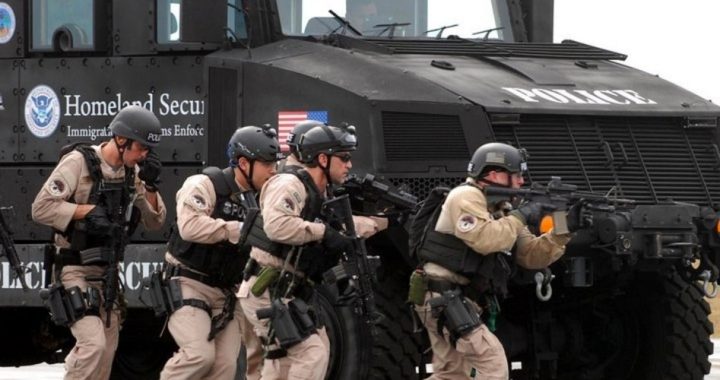
To an outside observer, it might appear that the U.S. Department of Homeland Security has taken on too many missions. But a series of articles appearing recently in the Albuquerque Journal in New Mexico suggests that the DHS has but a single mission: one called “everything.”
Created by an act of Congress signed by President George W. Bush in November 2002, just over one year after the September 11 terrorist attacks on the United States, the DHS merged 22 federal agencies into one vast department charged with the task of preventing terrorist attacks, reducing the nation’s vulnerability to terrorism, and assisting in the recovery from any terrorist acts that might occur and from any other disasters, natural or man-made. That might seem like a large enough task for any organization, even one that is currently the third largest department of the U.S. government. But DHS is also involved in many law enforcement and crime prevention efforts that appear far removed from combating terrorism and terrorist-related activities. In New Mexico, the Albuquerque paper reported, Homeland Security Investigation (HSI) officers have been working with local police and the state attorney general’s office on investigations regarding gang activity, missing and exploited children, pickpocket rings, and stolen and fraudulent Native American art.
“Native American culture is very important here in New Mexico, and we want to preserve that,” Kevin Abar, assistant special agent in charge of Homeland Security Investigations, explained to the Journal. Preserving culture might seem a far cry from defending the nation from terrorist attacks, but an investigative unit that has, according to the DHS website, 10,000 employees and 6,700 special agents in more than 200 U.S. cities and 47 foreign countries, is obviously waging a war on terror that knows no bounds. Some agents will even call on strip club dancers for their country, the Journal reported:
HSI isn’t just working criminal cases; it is also trying to prevent them. Last June, HSI’s Albuquerque field office announced it would meet with adult dancers and strip club owners to train them about the dangers of sex trafficking and how to recognize it. Agents are planning seminars and workshops at retirement centers to inform older residents about lottery, IRA and jail fraud schemes. And the agency last month announced a program that will send DHS officers into schools and nursing homes, where they will teach young and old alike about the dangers of Internet predators.
“We want to secure the Internet and make sure the individuals on it understand the pitfalls, and that they can become victims,” Abar said.
What the paper labeled “mission creep” by the department might more accurately be called mission gallop. The number of HSI officers in New Mexico has “more than quadrupled” in the past three years, Abar told the Journal. Nationally, the numbers reflect a success in empire building those outside the DHS tentacles might envy. Those 10,000 investigators are but a small part of an army of 240,000 people employed in various capacities by a department spending $61 billion this year, up from $29 billion in 2003, its first year of operation. And as the department has grown in size and dollars, it has developed what Abar described as a “symbiotic relationship” with local law enforcement.
“We are working side-by-side, literally — we are entrenched with our state and local counterparts,” the agent said.
New Mexico is also home to one of Homeland Security’s 78 “fusion centers” spread out across the country. Centers like the New Mexico All Source Intelligence Center, operating out of the National Guard complex in Santa Fe, exist to pool information, ostensibly about terrorist threats, from local, state, and federal agencies. In 2012, an investigative committee of the U.S. Senate published the results of a two-year long investigation of the DHS and its fusion centers and concluded:
Despite reviewing 13 months’ worth of reporting originating from fusion centers from April 1, 2009 to April 30, 2010, the Subcommittee investigation could identify no reporting which uncovered a terrorist threat, nor could it identify a contribution such fusion center reporting made to disrupt an active terrorist plot.
One example of “useless information” cited by the Senate committee was a report on a foreigner with an expired visa who had been caught speeding and shoplifting. The man’s name was added to the list of “known or appropriately suspected” terrorists. A reviewer of the report wrote that the only factual basis for the terror-suspect designation was that he “tried to steal a pair of shoes from Nieman Marcus.”
“I have no idea what value this would be adding to the IC [Intelligence Community],” the reviewer added.
Most Americans were unaware of the fusion centers until one of them, the Missouri Information Analysis Center, made headlines in 2009 by including Ron Paul supporters and anti-abortion activists as potential terror threats. A fusion center in Texas drew verbal fire from the American Civil Liberties Union for targeting anti-war activists and lobbyists for Islamic organizations.
The Senate report also detailed such questionable spending practices as purchases of “shirt button” cameras, $6,000 laptops, and big-screen televisions. One center, the report said, spent $45,000 on an SUV that a city official used for commuting. A spokesperson for DHS told Fox News at the time that the report was based on outdated information and that it “fundamentally misunderstands the role of the federal government in supporting fusion centers and overlooks the significant benefits of this relationship to both state and local law enforcement and the federal government.”
“They have not solved or prevented any terrorist acts in the United States,” Wendell Oliver, a retired Virginia police officer who has written two textbooks on homeland security told the Journal. “But there is also no evidence they have necessarily done any great harm — other than waste money.” It could be argued that, given the kind of people and organizations they have put on their “watch lists,” some of the fusion centers have also contributed to a climate and fear and suspicion that could pose a greater threat to the nation’s freedom and stability than wasteful and duplicative spending cited in studies of Homeland Security operations.
A 2012 report called Safety At Any Price, Sen. Tom Coburn (R-Okla.) cited the purchase of 13 sno-cone machines in Michigan and the $45 million spent on a failed video surveillance network in Illinois as examples of “dubious spending.” But when it comes to duplication and waste, it would be hard to beat the operations of Congress itself. If congressional “oversight” could solve the problems of waste and mismanagement in government agencies, we might have by now the most efficient government in the history of the world. There are 100 or more committees or subcommittees of Congress with some measure or jurisdiction over the Department of Homeland Security.
“We can only defend our freedoms by ensuring the dollars we spend on security are done so in a fiscally responsible manner, meet real needs, and respect the very rights we are aiming to preserve and protect,” Coburn wrote. In other words, Congress and the agencies it has created should stop playing the role of a fanatic — one who redoubles his effort (and his spending) when he has forgotten his aim.



